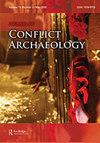回忆之外:寻找第一次世界大战英国秘密武器的遗迹
IF 0.6
0 ARCHAEOLOGY
引用次数: 6
摘要
本文讨论了Livens大型画廊火焰喷射器的发展,这是一种大型的英国火焰喷射器,在1916年的索姆河战役中用于对抗德国战壕。这个秘密武器建在无人区下面的地下隧道里,试图利用科技突破德军的防御,减少英军的伤亡。火焰喷射器是第一次世界大战中最有效的火焰喷射器,但被证明过于不灵活和昂贵而无法广泛使用。本文章由计算机程序翻译,如有差异,请以英文原文为准。
Beyond Recall: Searching for the Remains of a British Secret Weapon of World War I
Abstract This article discusses the development of the Livens Large Gallery Flame Projector, a massive British flamethrower that was used against German trenches in the Battle of the Somme in 1916. Built underground within tunnels below No Man’s Land, this secret weapon was an attempt to use technology to break through German defences and reduce British casualties. The flame projector was the most effective flamethrower developed in WWI, but proved to be too inflexible and expensive to be widely used.
求助全文
通过发布文献求助,成功后即可免费获取论文全文。
去求助
来源期刊

Journal of Conflict Archaeology
ARCHAEOLOGY-
CiteScore
0.80
自引率
50.00%
发文量
8
期刊介绍:
The Journal of Conflict Archaeology is an English-language journal devoted to the battlefield and military archaeology and other spheres of conflict archaeology, covering all periods with a worldwide scope. Additional spheres of interest will include the archaeology of industrial and popular protest; contested landscapes and monuments; nationalism and colonialism; class conflict; the origins of conflict; forensic applications in war-zones; and human rights cases. Themed issues will carry papers on current research; subject and period overviews; fieldwork and excavation reports-interim and final reports; artifact studies; scientific applications; technique evaluations; conference summaries; and book reviews.
 求助内容:
求助内容: 应助结果提醒方式:
应助结果提醒方式:


